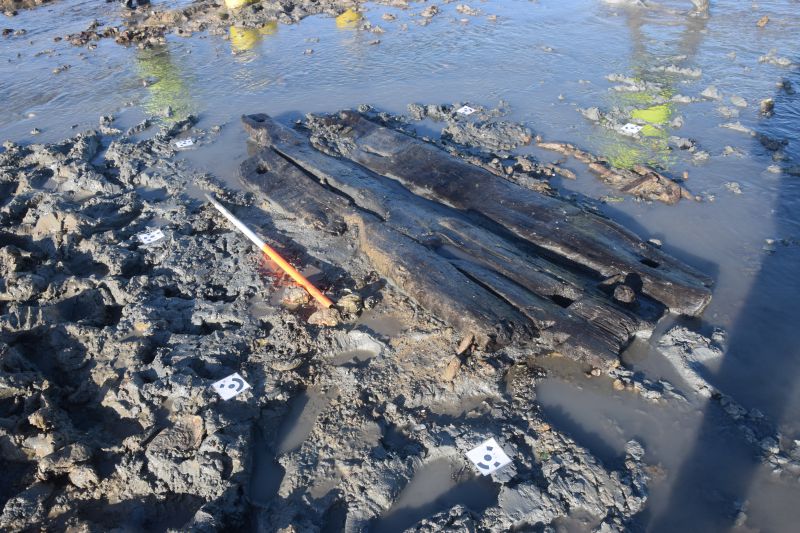| Notes on the woodworking aspects of the Late Bronze Age plank
trackway found at Coopers Beach Mersea
Purpose of these brief notes
To provide a summary of key woodworking features of the Late Bronze Age trackway to support the display of the conserved
original timbers on Mersea Island Essex, as requested by O Hutchinson of CITiZAN. A few key references have been supplied at the end.
Background - British prehistoric wooden trackways
Prehistoric wooden trackways, of various kinds, have been found in several parts of Britain, Ireland and some other regions of Europe. They have all been found in very waterlogged layers that stop the wood decaying, even over thousands of years. The trackway from Coopers Beach Mersea is the most solid and complex yet found the SE of England and parallels some trackways found in the Somerset Levels (1). The other wooden trackways found in the wet soil of the Thames Estuary flood plain have been much simpler being made mostly of small shoots and branches ( 'roundwood') laid in lines on the wet ground surfaces and only about 1m wide (2). Sometimes the roundwood was woven together, like a wattle hurdle then laid flat and in a few cases it was just supported by diagonal crossing stakes underneath. One heavier trackway was also found in Southwark, London, made of trimmed oak logs laid end to end, with stakes driven down on side as hand grips.
No others have been found in the SE yet made of planks, or of the scale of this Mersea example.
The basic form of the Coopers Beach trackway remains
Although some of the timbers of the trackway had been washed away before discovery enough remains that we can see its
original form and how it was made. The key surviving parts were 5 oak planks laid E-W, edge to edge forming part of a solid
trackway surface up to 2.5m (8') wide. The ends of the planks had roughly square holes through them, in which stakes would
originally have been set to lock them in place

The boards in situ

Painting by Paul Thrales showing construction
The planks were supported underneath by an assortment of poles and branches of oak and hazel to reduce the sinkage into the wet ground. There were also some small stakes and areas of sticks under the planks, perhaps suggesting that there was an earlier, lightly built trackway on the same line. This may just have been built to allow the building of the heavy plank trackway?
The planks and how they were made
All the planks were made of oak and carefully split out of logs. The wood workers followed the natural plains of weakness in the moderately straight timber and produce 'radially cleft' rough planks. They did not have saws for such work till the Romans arrived. The finest plank (Timber 3) was a 1/32nd section of the 'parent' log and others were 1/16ths. As there were some knotty sections in the timber they must have been very clever at this type of work. The ends of the planks were cut with an axe, and the roughly square holes for the stakes also. In wet conditions the roughness of the planks may have been an advantage, reducing slipping.
The oak trees they came from varied, from very narrow ringed, slow growth examples nearly 200 years old, to faster growing examples not much more than 100 years old. The largest diameter logs used were about 0.8m ( 2'4") diameter to the outside of the bark. There are very few oak trees like this on Mersea or nearby today. The two patterns of rings suggest that two separate areas of woodland were probably used.
At all stages making this trackway required much more effort than any of the other prehistoric trackways yet found in SE England.
Dating and the precise tool kits used
The key cutting tools were very small, distinctive axes with rounded blades up to just over 50mm ( 2") wide, which left
very clear marks in the square holes and the axe cut plank ends

Replica tool posed in relevant position over hole in Timber 1.
The implied tool(s) is the typical Late Bronze Age socketed axe. So we could suggest an approximate dating to around 1000 BC or about 3000 years old immediately !
Later the timbers were examined for tree-ring dating and one ( Timber 1) had a ring sequence that could be well matched to other dated sequences. Allowing for missing, decay prone sapwood, the tree-ring scientist Ian Tyers, was able to suggest a date for the cutting of the 'parent tree' of 952 BC or a few years later, ie the late Bronze Age.
The possible function of the wide, solid, Coopers Beach trackway, a cart or even chariot way??
The considerable width of up to 2.5m ( 8ft ), and about 1.8m between the locating stakes is very wide compared to other trackways known in the SE. Why was this? The width was enough to allow the use of small carts or possibly even chariots with care. Both are known from the Bronze Age onward. What do you think???
NB This last interpretation is not a joke but a real possibility, we may need to ask Paul Thrale to do another reconstruction
drawing !!
Ref (1) Orme, B, and Coles , J, 1983, Prehistoric woodworking from the Somerset Levels; 1.Timber, Somerset levels Papers No 8, 19-43
Ref (2) Stafford, E, , Goodburn, D, and Bates, M, 2012 Landscape and prehistory of the east London wetlands ; Investigations along the A13 DBFO road scheme, Tower Hamlets, Newham and Barking and Dagenham, Oxford Archaeology Monograph No 17
D.M. Goodburn BA Phd Archaeological Woodwork Specialist MOLA
Read More
Bronze Age Mersea by Oliver Hutchinson
The Bronze Age Board Walk - a trackway across the wetlands
|